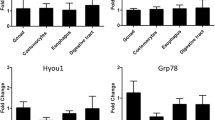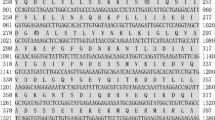Abstract
Exposure of organisms to heat stress induces the expression of evolutionarily conserved proteins called the stress proteins or heat shock proteins (HSPs). At the cellular level, HSPs by acting as molecular chaperone prevents the heat induced aggregation of denatured proteins and play a significant role in adaptation to temperature. Among different HSP family members, Hsp70 is the highly conserved and ubiquitously expressed protein. The present study is carried out to detect changes in the localization of Hsp70/Hsc70 in gill and heart tissues of control and heat shocked juveniles of Macrobrachium malcolmsonii that could be correlated with the functional significance of these two isoforms. Two groups of prawn acclimated at 30 °C were exposed to reported optimum Hsp70 induction temperatures of 36 °C and 38 °C for heart and gill, respectively, for a duration of 48 h. These tissues were processed by immunocytochemical methods to detect intra-cellular localization of Hsp70/Hsc70. Western blotting analysis was performed to determine the cytoplasmic or nuclear localization of Hsp70/Hsc70 and band intensity was detected in total lysate, cytosolic and nuclear extracts of gill and heart tissue. The present investigation clearly shows that there are alterations in the intracellular localization of Hsp70/Hsc70 in the cells of the gill and heart tissues of M. malcolmsonii following heat stress. The western blotting results corroborate the results obtained by immunohistochemical localisation. The differential intracellular localization of Hsp70/Hsc70 appears to indicate the functional roles of this stress protein during exposure to thermal stress.





Similar content being viewed by others
References
Madeira D, Narciso L, Cabral HN, Diniz MS, Vinagre C (2014) Role of thermal niche in the cellular response to thermal stress: lipid peroxidation and HSP70 expression in coastal crabs. Ecol Ind 36:601–606
Cardoso CM, Sartorio PV, Machado ASD et al (2015) Hsp70 and p53 expressions and behavior of juvenile pompano, Trachinotus carolinus (Perciformes, Carangidae), at controlled temperature increase. J Exp Mar Biol Ecol 470:34–42
Parsell DA, Lindquist S (1994) Heat shock proteins and stress tolerance. In: Morimoto RI, Tissieres A, Georgopoulos C (eds) The biology of heat shock proteins and molecular chaperones. Cold spring harbor laboratory, New York, pp 457–494
Feige U, Morimoto RI, Polla B (2013) Stress-inducible cellular responses. Birkhäuser, Boston
Ritossa F (1962) A new puffing pattern induced by temperature shock and DNP in Drosophila. Cell Mol Life Sci 18:571–573
Tsan MF, Gao B (2004) Heat shock protein and innate immunity. Cell Mol Immunol 1:274–279
Akerfelt M, Morimoto RI, Sistonen L (2010) Heat shock factors: integrators of cell stress, development and lifespan. Nat Rev Mol Cell Biol 11:545–555
Kampinga HH, Craig EA (2010) The HSP70 chaperone machinery: J proteins as drivers of functional specificity. Nat Rev Mol Cell Biol 11:579–592
Cherkasov V, Hofmann S, Druffel-Augustin S, Mogk A, Tyedmers J, Stoecklin G, Bukau B (2013) Coordination of translational control and protein homeostasis during severe heat stress. Curr Biol 23:2452–2462
Kodiha M, Stochaj U (2013) Chaperones and multitasking proteins in the nucleolus. In O’Day DH, Catalano A (eds) Proteins of the nucleolus. Springer Netherlands, pp 149–172
Yamashita M, Hirayoshi K, Nagata K (2004) Characterization of multiple members of the HSP70 family in platyfish culture cells: molecular evolution of stress protein HSP70 in vertebrates. Gene 336:207–218
Yang YN, Ye H, Huang H, Li S, Liu X, Zeng X, Gong J (2013) Expression of Hsp70 in the mud crab, Scylla paramamosain in response to bacterial, osmotic, and thermal stress. Cell Stress Chaperones 18:475–482
Rao KG, Reddy OR, Rao PR, Ramakrishna R (1986) Monoculture of Indian freshwater prawn, Macrobrachium malcolmsonii (Milne Edwards). Aquaculture 53:67–73
Koolhaas JM, Bartolomucci A, Buwalda BD et al (2011) Stress revisited: a critical evaluation of the stress concept. Neurosci Biobehav Rev 35:1291–1301
Jiang W, Li J, Gao Y et al (2016) Effects of temperature change on physiological and biochemical responses of Yesso scallop, Patinopecten yessoensis. Aquaculture 451:463–472
Selvakumar S, Geraldine P (2003) Thermal modulation of pyruvate metabolism in the freshwater prawn Macrobrachium malcolmsonii: the role of lactate dehydrogenase. Fish Physiol Biochem 29:149–157
Selvakumar S, Geraldine P (2005) Heat shock protein induction in the freshwater prawn Macrobrachium malcolmsonii: acclimation-influenced variations in the induction temperatures for Hsp70. Comp Biochem Physiol A: Mol Integr Physiol 140:209–215
Selvakumar S, Geraldine P, Shanju S, Jayakumar T (2005) Stressor-specific induction of heat shock protein 70 in the freshwater prawn Macrobrachium malcolmsonii (H. Milne Edwards) exposed to the pesticides endosulfan and carbaryl. Pestic Biochem Physiol 82:125–132
Lowry OH, Rosebrough NJ, Farr AL, Randall RJ (1951) Protein measurement with the Folin phenol reagent. J Bio Chem 193:265–275
Dimauro I, Pearson T, Caporossi D, Jackson MJ (2012) A simple protocol for the subcellular fractionation of skeletal muscle cells and tissue. BMC Res Notes 5:513
Laemmli UK (1970) Cleavage of structural proteins during the assembly of the head of bacteriophage T4. Nature 227(5259):680
Towbin H, Staehelin T, Gordon J (1979) Electrophoretic transfer of proteins from polyacrylamide gels to nitrocellulose sheets: procedure and some applications. Proc Natl Acad Sci 76:4350–4354
Boorstein WR, Ziegelhoffer T, Craig EA (1994) Molecular evolution of the HSP70 multigene family. J Mol Evol 38(1):1–17
Liu J, Yang WJ, Zhu XJ, Karouna-Renier NK, Rao RK (2004) Molecular cloning and expression of two HSP70 genes in the prawn, Macrobrachium rosenbergii. Cell Stress Chaperones 9(3):313–323
Airaksinen S, Jokilehto T, Rabergh CM, Nikinmaa M (2003) Heat and cold-inducible regulation of HSP70 expression in zebrafish ZF4 cells. Comp Biochem Physiol B: Biochem Mol Biol 136(2):275–282
Welch WJ, Feramisco JR (1984) Nuclear and nucleolar localization of the 72,000-dalton heat shock protein in heat-shocked mammalian cells. J Biol Chem 259:4501–4513
Bensaude O, Pinto M, Dubois MF, Van Trung N, Morange M (1990) Protein denaturation during heat shock and related stress. In Schlesinger MJ, Santoro MG, Garaci E (eds) Stress proteins. Springer, Berlin, pp 89–99
Ku CC, Chen SN (1992) Characterization of three cell lines derived from color carp Cyprinus carpio. J Tissue Cult Methods 14:63–71
Ohtsuka K, Hata M (2000) Molecular chaperone function of mammalian Hsp70 and Hsp40: a review. Int J Hyperth 16:231–245
Pelham HR (1986) Speculations on the functions of the major heat shock and glucose-regulated proteins. Cell 46(7):959–961
Mayer MP, Bukau B (2005) Hsp70 chaperones: cellular functions and molecular mechanism. Cell Mol Life Sci 62:670–684
Benbahouche NEH, Iliopoulos I, Török I et al (2014) Drosophila Spag is the homolog of RNA polymerase II-associated protein 3 (RPAP3) and recruits the heat shock proteins 70 and 90 (Hsp70 and Hsp90) during the assembly of cellular machineries. J Biol Chem 289:6236–6247
Gong Y, Kakihara Y, Krogan N, Greenblatt J, Emili A, Zhang Z, Houry WA (2009) An atlas of chaperone–protein interactions in Saccharomyces cerevisiae: implications to protein folding pathways in the cell. Mol Syst Biol 5:275
Funikov SY, Ryazansky SS, Kanapin AA et al (2016) Interplay between RNA interference and heat shock response systems in Drosophila melanogaster. Open Biol 6:160224
Kregel KC (2002) Invited review: heat shock proteins: modifying factors in physiological stress responses and acquired thermotolerance. J Appl Physiol 92:2177–2186
Lepock JR (2004) Role of nuclear protein denaturation and aggregation in thermal radiosensitization. Int J Hyperth 20:115–130
Voos W (2013) Chaperone–protease networks in mitochondrial protein homeostasis. Biochim Biophys Acta (BBA)-Mol Cell Res 1833(2):388–399
Acknowledgements
The authors thank the Department of Science and Technology, Govt. of India for the financial assistance provided.
Author information
Authors and Affiliations
Corresponding author
Ethics declarations
Conflict of interest
The authors declare that they have no conflict of interest.
Rights and permissions
About this article
Cite this article
Muthuswamy, K., Shanmugam Prema, D., Krishnan, V. et al. Differential intracellular localization of Hsp70 in the gill and heart tissue of fresh water prawn Macrobrachium malcolmsonii during thermal stress. Mol Biol Rep 45, 1321–1329 (2018). https://doi.org/10.1007/s11033-018-4291-8
Received:
Accepted:
Published:
Issue Date:
DOI: https://doi.org/10.1007/s11033-018-4291-8




